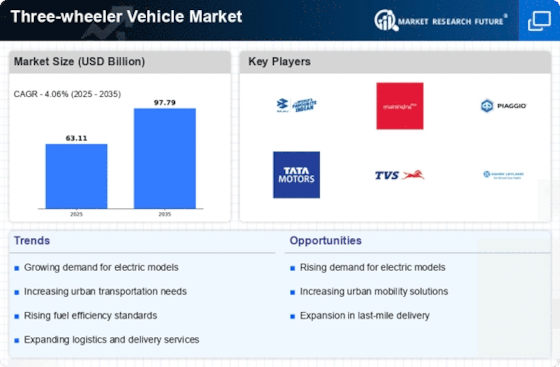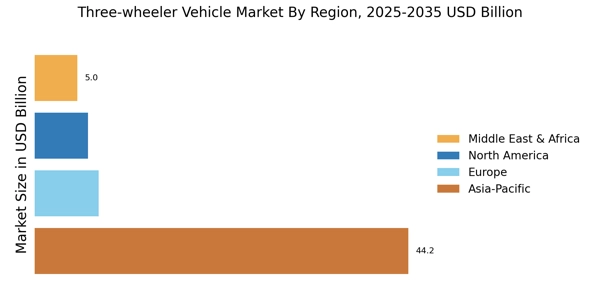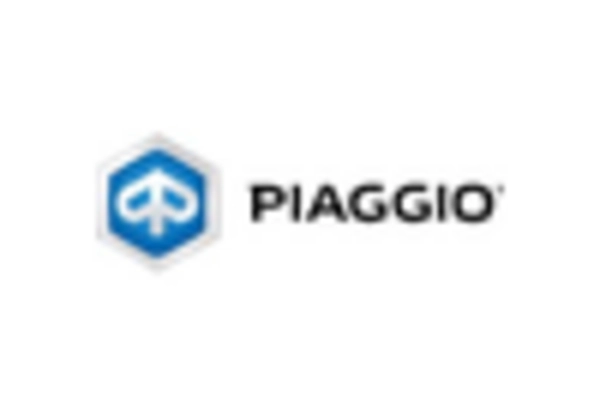Government Initiatives and Support
Government initiatives aimed at promoting sustainable transportation are significantly influencing the Three-wheeler Vehicle Market. Various countries are implementing policies that encourage the adoption of eco-friendly vehicles, including three-wheelers. Incentives such as subsidies, tax breaks, and infrastructure development for electric three-wheelers are becoming increasingly common. For instance, several governments have set ambitious targets for reducing carbon emissions, which could lead to a substantial increase in the adoption of electric three-wheelers. Data indicates that regions with supportive policies have seen a rise in electric three-wheeler sales by over 30% in the past year. This governmental backing not only fosters innovation but also enhances consumer confidence in three-wheeler technology, thereby propelling the market forward.
Rising Demand for Last-Mile Connectivity
The Three-wheeler Vehicle Market is experiencing a notable surge in demand for last-mile connectivity solutions. As urbanization accelerates, the need for efficient transportation options in densely populated areas becomes increasingly critical. Three-wheelers, with their compact size and maneuverability, are well-suited for navigating congested streets. According to recent data, the last-mile delivery segment is projected to grow at a compound annual growth rate of approximately 10% over the next five years. This trend indicates a shift in consumer preferences towards more agile and cost-effective transportation methods, positioning three-wheelers as a preferred choice for both passengers and goods. The adaptability of three-wheelers to various urban environments further enhances their appeal, suggesting a robust future for this segment within the Three-wheeler Vehicle Market.
Increasing Fuel Prices and Economic Factors
The Three-wheeler Vehicle Market is being significantly impacted by rising fuel prices and broader economic factors. As fuel costs continue to escalate, consumers are increasingly seeking cost-effective transportation alternatives. Three-wheelers, known for their fuel efficiency, are becoming a preferred choice for both personal and commercial use. Data indicates that the demand for three-wheelers has risen by approximately 20% in regions where fuel prices have surged. Additionally, economic factors such as inflation and changing consumer spending habits are influencing purchasing decisions. The affordability and operational efficiency of three-wheelers position them as a viable solution in challenging economic climates, suggesting a sustained demand within the Three-wheeler Vehicle Market.
Technological Advancements in Vehicle Design
Technological advancements are playing a pivotal role in shaping the Three-wheeler Vehicle Market. Innovations in vehicle design, such as improved aerodynamics, lightweight materials, and enhanced safety features, are making three-wheelers more appealing to consumers. The integration of smart technologies, including GPS navigation and telematics, is also enhancing the functionality of these vehicles. Recent studies suggest that the introduction of advanced safety features has led to a 15% increase in consumer interest in three-wheelers. Furthermore, the development of electric and hybrid models is expanding the market's reach, catering to environmentally conscious consumers. As manufacturers continue to invest in research and development, the potential for growth in the Three-wheeler Vehicle Market appears promising.
Expansion of E-Commerce and Delivery Services
The expansion of e-commerce and delivery services is driving growth in the Three-wheeler Vehicle Market. As online shopping continues to gain traction, the need for efficient delivery solutions has become paramount. Three-wheelers, with their ability to navigate narrow streets and congested urban areas, are increasingly being utilized for last-mile delivery. Recent statistics indicate that the e-commerce sector is expected to grow by over 15% annually, creating a substantial demand for delivery vehicles. This trend is likely to bolster the three-wheeler segment, as businesses seek cost-effective and agile transportation options. The versatility of three-wheelers in handling various types of cargo further enhances their attractiveness in the evolving logistics landscape, indicating a bright future for the Three-wheeler Vehicle Market.


















Leave a Comment